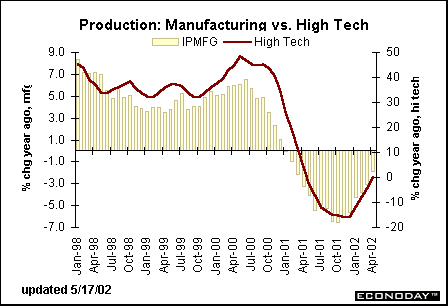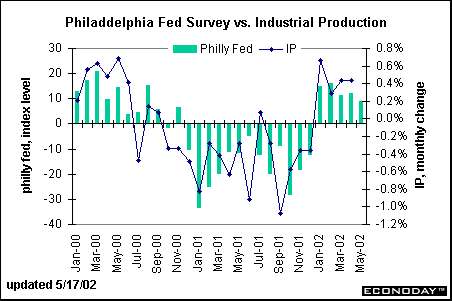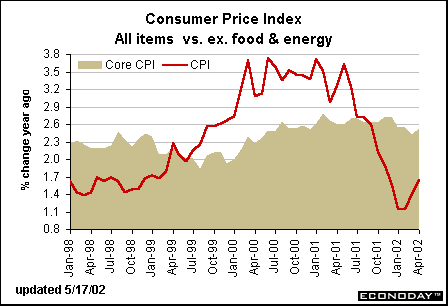The EconomyConsumers in the lead Retail sales jumped 1.2 percent in April after posting smaller gains in the three previous months. The monthly volatility has been generally associated with motor vehicle sales, which rose in April after declining sharply in January and March. Auto and truck sales excluded, retail sales recorded solid gains in January (1.1 percent) and April (1.0 percent) and moderate gains in February (0.5 percent) and March (0.3 percent). In three of the past four months, gasoline prices have risen sharply in turn affecting sales at gas stations. Consequently, one should look at retail sales excluding autos and gas stations. Sales were healthy, although a bit slower. Nevertheless, there is no question that the consumer sector is leading the economy out of its slump. 
Low mortgage rates continue to benefit the housing market. Admittedly, housing starts fell 5.4 percent in April after an 8.1 percent drop in March. But keep in mind that January and February housing starts were at a two-year high. Even with the two-month drop, total housing starts as well as single-family housing construction remain at the high levels recorded throughout 2001. After all is said and done, it is likely that actual construction was not as strong as the January and February figures suggest. But at the same time, actual construction was probably better than the figures suggest for March and April. The first two months of the year saw an unseasonably warm winter, while March and April are turning out to be relatively normal. 
Mortgage rates were at their lowest level in October and November, but even at the recent 7 percent trend they are not particularly high by historical standards. Amazingly, mortgage rates have remained remarkably stable for five months now. This is likely to benefit the housing market in the next few months as well. Continued strength in the housing market should generate higher retail sales for furniture and appliances in the next few months. Early indications show that consumers might start getting more upbeat about the economy. The mid-month reading on the University of Michigan’s consumer sentiment index recorded a mild rise to 96 from a level of 93 in April. Broad consumer spending trends move in tandem with confidence; thus, as consumers become more optimistic in the next few months, that should translate into higher retail sales. Production improves slowly The index of industrial production increased 0.4 percent in April after a downwardly revised gain in March. Production of consumer goods, business equipment and materials managed to post gains for the month. However, production of construction supplies decreased in April. Among the major market groups, only consumer goods are up from year ago levels. Production of business equipment is posting the largest decline from a year ago, down 9.9 percent. Equity investors have been beating up on the high tech area with the Nasdaq composite index feeling the brunt of the blow. Production figures actually have shown pretty healthy gains for selected high tech industries. For instance, this sector has posted an average monthly gain of 1.1 percent since last October. The year-over-year declines have become smaller and smaller and approached zero in April. The chart below shows that growth in high tech production has mirrored growth in manufacturing production. Yet, total manufacturing production is still down 1.9 percent from a year ago while high tech production is only down 0.2 percent through April. 
Perhaps one reason that industrial production is posting such slow growth is that manufacturers are going overseas for products. Imports jumped 3.7 percent in both January and February, though they only edged up 0.3 percent in March. Imports of consumer goods have grown faster than imports of capital goods in the past few months, but both are up as the U.S. economy recovers from the 2001 recession. On a year-over-year basis, exports have also gained but not as much as imports since the U.S. economy is growing faster than its primary trading partners. 
The pace of industrial production may not accelerate soon. A reflection of the week's economic mixed bag, the Philadelphia Fed’s business outlook survey, which is a leading indicator of industrial production, edged down in May to a level of 9.1 from 12.3 in April. While any level above 0 signifies an expanding manufacturing sector, it does appear that the levels from March through May have slowed relative to the first two months of the year. As evident from the chart below, the index of industrial production tends to move closely in line with the business outlook survey. Thus, on its own, the Philadelphia Fed data would suggest that industrial production growth should be modest in May and not accelerate from the 0.4 percent gains of the past two months. 
Special factors cause CPI acceleration The consumer price index rose 0.5 percent in April after recording smaller increases in the past three months. Energy prices jumped 4.5 percent in April after March’s 3.8 percent gain. Food prices edged up a meager 0.1 percent, but didn’t decline as they did in the PPI a week ago. Excluding food and energy prices, the CPI rose 0.3 percent in April. A 6.5 percent surge in tobacco prices was behind the acceleration in the core CPI. Prices of other goods and services remained relatively moderate. 
We find that the distinction between changes in prices of goods and services does a better job of distinguishing between core components than the conventional method of just breaking out the food and energy prices. Food and energy are certainly in the goods component, but so are tobacco products. In any case, prices of goods tend to move more dramatically than prices of services over short time frames. Notice how stable prices of services remained throughout 1998 and 1999. These prices then began to increase in 2000 and 2001. Prices of services have since slowed in the past year. Since services account for nearly 60 percent of the CPI, this component is somewhat more relevant than goods in terms of inflationary pressures. If prices of services continue their downward trend, it will help to keep inflation in check over the coming year and give the Fed leeway in determining monetary policy. 
| ![[Back To Archive]](../../../images/backtoarchive.gif)